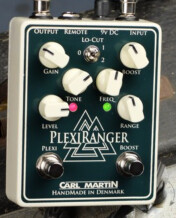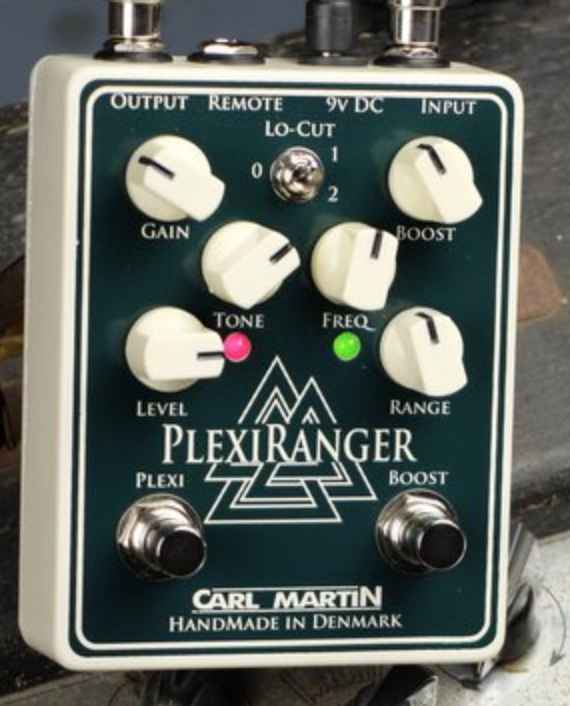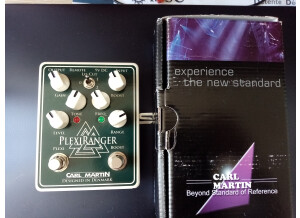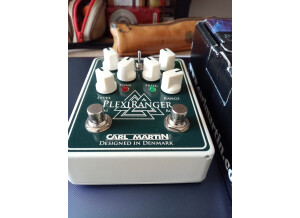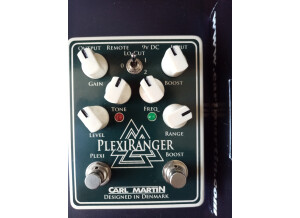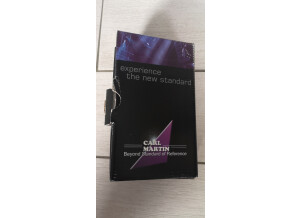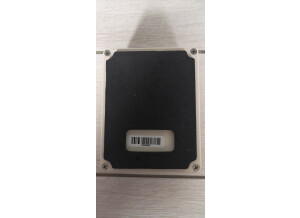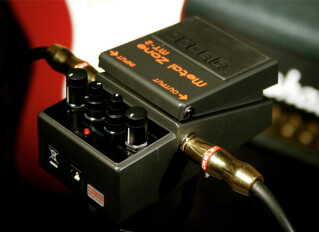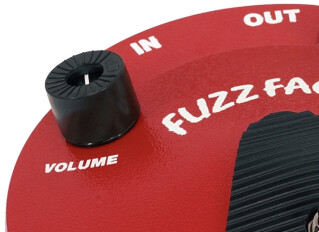Buy new Carl Martin PlexiRanger
- Thomann In stock / Delivered in 24h €155.00
PlexiRanger classified ad
New ad alertImages
Videos
Reviews
5.0/5(1 reviews)
100 %
Write a user review
OD and Treble Booster in one, with a wide range of 'cutting' tones
Published on 07/14/21 at 02:38Carl Martin produces some very solid pedals, in that they sound good, are easy to operate and deliver what’s promised. The PlexiRanger is no exception, as it combines Carl Martin’s classic Plexi in a box, together with a treble booster, both of which can be operated independently or together (each with its own footswitch and LED). The demo below includes a composition, followed by various settings with different amps, from clean to hi-gain.
The Plexi overdrive side of the pedal delivers a very fine drive grain (some drives sound thick and coarse, whereas this drive sizzles with clarity). Even with the Gain turned all the way down, there is an immediate excitement in the tone, similar...…
The Plexi overdrive side of the pedal delivers a very fine drive grain (some drives sound thick and coarse, whereas this drive sizzles with clarity). Even with the Gain turned all the way down, there is an immediate excitement in the tone, similar...…
Read more
Carl Martin produces some very solid pedals, in that they sound good, are easy to operate and deliver what’s promised. The PlexiRanger is no exception, as it combines Carl Martin’s classic Plexi in a box, together with a treble booster, both of which can be operated independently or together (each with its own footswitch and LED). The demo below includes a composition, followed by various settings with different amps, from clean to hi-gain.
The Plexi overdrive side of the pedal delivers a very fine drive grain (some drives sound thick and coarse, whereas this drive sizzles with clarity). Even with the Gain turned all the way down, there is an immediate excitement in the tone, similar to adding a Tube Screamer with gain all the way down. To add a bit more dirt requires a very slight increase in the Gain, but only a few millimeters. Once set at the 9-o’clock level, there is a hefty dose of crunch and classic rock drive. Anything past 10-o’clock and the tone pushes rather hard. On a clean channel, and with the Gain anywhere from 1-o’clock to full blast, the tone is classic hard rock that begins to delve into hi-gain territory (although still ‘classic’ sounding). When working with an already dirty amp (particularly hi-gain amps), a little goes a long way, and the Gain merely has to be set all the way down to about 10-o’clock at most… perhaps a touch higher for lead. This depends on the amp and how driven it already sounds, and often I found it best to keep the amp’s gain below what I typically would set it, and then add a bit of PlexiRanger thereafter. The Level and Gain work together, in that as one increases the other may need to decrease to maintain unity.
The tone of the Plexi side has a brighter sound; consequently, with the Tone knob set at 12-noon, you will have to dip into the bass side to maintain a similar tone to that of the amp (in other words 12-noon may be ‘flat’ for this pedal, but will sound brighter relative to your amp). If the amp is dark and you want to brighten it up, then the Plexi drive will please you. The entire spectrum of the Tone is very usable, in that full bass or full treble does not sound out of place, unless working with an unusually dark or bright amp (or pickups). There is no mud nor shrill, making the Tone spectrum both flexible and practical on many levels.
The treble booster (aka RangeMaster clone) side serves various purposes. It can give upward of 15dB of clean boost, but also add that bite and clarity to really cut through the mix. Along with that classic Plexi drive tone in classic rock, treble boosters have been around for some time, and since the early 1970sl they helped to form the signature tones of Iommi and May, for example. There are several features to the booster side of the PlexiRanger. First, the more Boost you add, the more of a ‘breaking up’ quality as you push the amp. Consequently, there is some modest ‘drive’ quality and without using the Drive side of the pedal. However, the extent of this quality is controlled by the Range knob, allowing you to add a little or a lot of the Boost quality and volume and relative to where you set the Boost. Second, the Freq knob allows you to zero in on what frequency you want boosted, from the upper middle-range to the upper range, which really helps to separate the guitar from other instruments in the mix, besides crafting the tone even further. Third, there is a Lo-Cut switch, and when set to zero (0), there is no change. When set to 1, there is a modest cut of the low end, and with setting 2 producing a bigger cut. This is very useful for dark amps and pickups, but also for those hi-gain amps when chugging, and when the chug tends to have too much bass pop and punch. In effect, the lo-cut will assist in tightening up that low end for better clarity and attack.
Now, although both can work independently, when you add the treble boost to the hot Plexi drive, you achieve excellent sustain and a singing quality in the notes when playing lead, as well as greater note definition and harmonics with rhythm chording. The PlexiRanger allows you to make cleans come alive or push the envelope of a dirty amp – and with improved clarity. At $249 USD, the PlexiRanger is a moderately priced pedal, but considering this is two pedals in one, that can work independently or in perfect harmony, it is priced reasonably for its diversity, tone options and ability to work with any amp. It operates on a basic 9VDC negative-tip power supply (100mA consumption) and also has a Remote input so that you can latch/unlatch the Boost side with a different footswitch.
The Plexi overdrive side of the pedal delivers a very fine drive grain (some drives sound thick and coarse, whereas this drive sizzles with clarity). Even with the Gain turned all the way down, there is an immediate excitement in the tone, similar to adding a Tube Screamer with gain all the way down. To add a bit more dirt requires a very slight increase in the Gain, but only a few millimeters. Once set at the 9-o’clock level, there is a hefty dose of crunch and classic rock drive. Anything past 10-o’clock and the tone pushes rather hard. On a clean channel, and with the Gain anywhere from 1-o’clock to full blast, the tone is classic hard rock that begins to delve into hi-gain territory (although still ‘classic’ sounding). When working with an already dirty amp (particularly hi-gain amps), a little goes a long way, and the Gain merely has to be set all the way down to about 10-o’clock at most… perhaps a touch higher for lead. This depends on the amp and how driven it already sounds, and often I found it best to keep the amp’s gain below what I typically would set it, and then add a bit of PlexiRanger thereafter. The Level and Gain work together, in that as one increases the other may need to decrease to maintain unity.
The tone of the Plexi side has a brighter sound; consequently, with the Tone knob set at 12-noon, you will have to dip into the bass side to maintain a similar tone to that of the amp (in other words 12-noon may be ‘flat’ for this pedal, but will sound brighter relative to your amp). If the amp is dark and you want to brighten it up, then the Plexi drive will please you. The entire spectrum of the Tone is very usable, in that full bass or full treble does not sound out of place, unless working with an unusually dark or bright amp (or pickups). There is no mud nor shrill, making the Tone spectrum both flexible and practical on many levels.
The treble booster (aka RangeMaster clone) side serves various purposes. It can give upward of 15dB of clean boost, but also add that bite and clarity to really cut through the mix. Along with that classic Plexi drive tone in classic rock, treble boosters have been around for some time, and since the early 1970sl they helped to form the signature tones of Iommi and May, for example. There are several features to the booster side of the PlexiRanger. First, the more Boost you add, the more of a ‘breaking up’ quality as you push the amp. Consequently, there is some modest ‘drive’ quality and without using the Drive side of the pedal. However, the extent of this quality is controlled by the Range knob, allowing you to add a little or a lot of the Boost quality and volume and relative to where you set the Boost. Second, the Freq knob allows you to zero in on what frequency you want boosted, from the upper middle-range to the upper range, which really helps to separate the guitar from other instruments in the mix, besides crafting the tone even further. Third, there is a Lo-Cut switch, and when set to zero (0), there is no change. When set to 1, there is a modest cut of the low end, and with setting 2 producing a bigger cut. This is very useful for dark amps and pickups, but also for those hi-gain amps when chugging, and when the chug tends to have too much bass pop and punch. In effect, the lo-cut will assist in tightening up that low end for better clarity and attack.
Now, although both can work independently, when you add the treble boost to the hot Plexi drive, you achieve excellent sustain and a singing quality in the notes when playing lead, as well as greater note definition and harmonics with rhythm chording. The PlexiRanger allows you to make cleans come alive or push the envelope of a dirty amp – and with improved clarity. At $249 USD, the PlexiRanger is a moderately priced pedal, but considering this is two pedals in one, that can work independently or in perfect harmony, it is priced reasonably for its diversity, tone options and ability to work with any amp. It operates on a basic 9VDC negative-tip power supply (100mA consumption) and also has a Remote input so that you can latch/unlatch the Boost side with a different footswitch.
See less
00
»
Audio excerpts
-
00:0001:47

-
00:0001:09

-
00:0003:11

Tech. sheet
- Manufacturer: Carl Martin
- Model: PlexiRanger
- Category: Overdrive pedals
- Package weight:471 g
- Added in our database on: 01/13/2020
We have no technical specifications for this product
but your help will be much welcomed
»
Other categories in Saturation effects pedals
Other names: plexi ranger


